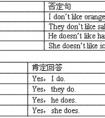按要求改写下列句子。1. Tom is in Class Six.Mary is in ClassSix,too.( 改为同义句)They are in__________ _____.2. There are many books on the table,_____ _____-八年级英语
题文
| 按要求改写下列句子。 |
| 1. Tom is in Class Six.Mary is in ClassSix,too.( 改为同义句) They are in _____ _____ _____. 2. There are many books on the table, _____ _____?( 完成反意疑问句) 3. His father has been a teacher for five years.( 就画线部分提问) _____ _____ has his father been a teacher? 4. It is time for supper. ( 改为同义句) It is time _____ _____ supper. 5. Maybe he is at home. ( 改为同义句) He _____ _____ at home. |
答案
| 1. the same class 2. aren't there 3. How long 4. to have 5. may be |
据专家权威分析,试题“按要求改写下列句子。1. Tom is in Class Six.Mary is in Clas..”主要考查你对 相互代词,情态动词,不定式,反意疑问句,疑问词组 等考点的理解。关于这些考点的“档案”如下:
相互代词情态动词不定式反意疑问句疑问词组
考点名称:相互代词
- 相互代词:
就是表示相互关系的代词。它与它所指代的名词或代词是一种互指关系,因此它们是复数或者二者以上。
英语中的相互代词只有两个,即each other和one another。
在正式文体中多用each other指两者,用one another指两者以上。
我们应当把它们当作复合代词看待,即使在分开使用时,它们也是相互关联的。
在句中,相互代词可用作宾语、定语等。例如:
Don't talk to each other (one another).
We must help one another. - 相互代词的用法:
相互代词只有each other和one another两个词组。他们表示句中动词所叙述的动作或感觉在涉及的各个对象之间是相互存在的,例如:
It is easy to see that the people of different cultures have always copied each other.
显而易见,不同文化的人总是相互借鉴的。
相互代词的句法功能:
a. 作动词宾语;
We often help each other in our lessons.
我们经常在功课上互相帮助。
They see one another every day.
他们每天见面
b. 可作介词宾语;
Does bark, cocks crow, frogs croak to each other.
狗吠、鸡鸣、蛙儿对唱。
说明:传统语法认为,相互关系存在于两个人或物之间用each other,存在于两个以上人和物之间用one another。
现代英语中,两组词交替使用的实例也很多,例如:
He put all the books beside each other.
他把所有书并列摆放起来。
He put all the books beside one another.
他把所有书并列摆放起来。
Usually these small groups were independent of each other.
这些小团体通常是相互独立的。
c.作定语时须用所有格
The students borrowed each other's notes.
学生们互借笔记。 相互代词each other和one another的区别:
1. 一般认为 each other 指两者,other another指三者或三者以上。但在实际运用中,这两个短语常可互换:
We respect each other [one another]. 我们互相尊重 (对方)。
The sea and the sky seemto melt into one another [each other]. 大海和蓝天似乎融为一体。
2. 两者均有所有格:They know each other’s [one another’s] weak points. 他们都彼此了解对方的缺点。
3. each other 可折开用 (each…the other),而 one another则不能:
We helped each other. =We each helped the other. 我们互相帮助。
4. 汉语的“互相”是副词,但是英语中的 each other 和 oneanother均为代词,因此在及物动词之后可直接用作宾语 (如help eachother);
而在不及物动词之后,则要借助介词 (如talk to each other, learn from one another 等)。
5.这两个短语均不能用作主语:
正:We each know what the other thinks.
误:We know what each other [one another] thinks.
正因为不能用作主语,所以用它们作宾语的句子不能改为被动语态。
考点名称:情态动词
- 情态动词:
是一种本身有一定的词义,表示说话人的情绪、态度或与语气的动词,但不能单独作谓语,只能和其他动词原形构成谓语。
无人称和数的变化,情态动词后面跟的动词需用原形,否定式构成是在情态动词后面加 “not”。
个别情态动词有现在式和过去式两种形式,过去式用来表达更加客气,委婉的语气, 时态性不强,可用于过去,现在或将来。情态动词属非及物动词,故没有被动语态。
情态动词有四类:
①只做情态动词:must, can(could),may(might)……
②可做情态动词又可做实义动词:need, dare
③具有情态动词特征:have(had, has) to, used to
④情态动词表猜测
注:mustn't代表强烈禁止 must表示主观,have to表示客观。
常用的有:can may could must have use . 情态动词特点:
情态动词无人称和数的变化,情态动词后面跟的动词须用原形,否定式构成是在情态动词后面加 "not"。
个别情态动词有现在式和过去式两种形式,过去式用来表达更加客气,委婉的语气,时态性不强,可用于过去,现在或将来。情态动词属非及物动词,故没有被动语态。
He could be here soon.他很快就来。
We can't carry the heavy box.我们搬不动那箱子。
I'm sorry I can't help you.对不起,我帮不上你。
基本助动词与情态助动词最主要的区别之一是:
基本助动词本身没有词义,而情态助动词则有自己的词义,能表示说话人对有关动作或状态的看法,或表示主观设想:
What have you been doing since? (构成完成进行体,本身无词义)
I am afraid I must be going. (一定要)
You may have read some account of the matter. (或许已经)
除此之外,情态助动词还有如下词法和句法特征:
1) 除ought和used以外,其他情态动词后面只能接不带to的不定式。如果我们把ought to和used to看做是固定词组的话,那么,所有情态动词无一例外地只能接不带to的不定式:
We used to grow beautiful roses.我们过去常常种这种漂亮的玫瑰花
I asked if he would come and repair my television set.我问他是否来修我的电视机
2) 情态助动词在限定动词词组总是位居第一:
They need not have been punished so severely.
3) 情态助动词用于第三人称单数现在时的时候,没有词形变化,即其词尾无-s形式:
She dare not say what she thinks.
4) 情态动词没有非限定形式,即没有不定式和分词形式,也没有相应的动名词:
Still,she needn't have run away.
5)情态助动词的“时”的形式并不是时间区别的主要标志。在不少场合,情态助动词的现在时和过去时形式都可以表示现在、过去或将来时间:
Would you mind very much if I ask you to do something?
She told him he ought not to have done it.
6) 情态助动词之间是相互排斥的,即在一个限定动词词组中只能出现一个情态助动词,但有时却可以与have和be基本助动词连用:
You should have washed the wound.
Well,you shouldn't be reading a novel.
7)情态动词must一般疑问句否定回答用needn't
Must I read books every day、
No,you needn't常见情态动词用法:
- 最新内容
- 相关内容
- 网友推荐
- 图文推荐
| [家长教育] 孩子为什么会和父母感情疏离? (2019-07-14) |
| [教师分享] 给远方姐姐的一封信 (2018-11-07) |
| [教师分享] 伸缩门 (2018-11-07) |
| [教师分享] 回家乡 (2018-11-07) |
| [教师分享] 是风味也是人间 (2018-11-07) |
| [教师分享] 一句格言的启示 (2018-11-07) |
| [教师分享] 无规矩不成方圆 (2018-11-07) |
| [教师分享] 第十届全国教育名家论坛有感(二) (2018-11-07) |
| [教师分享] 贪玩的小狗 (2018-11-07) |
| [教师分享] 未命名文章 (2018-11-07) |


